In 2025, managing multiple social media platforms without a reliable scheduling tool is a recipe for chaos.
As businesses increasingly rely on social media to drive engagement, brand visibility, and revenue, the demand for robust and efficient scheduling tools has never been higher.
This guide breaks down the 15 best social media scheduling tools for business, including Social Champ, each carefully reviewed to help you pick the right platform based on your unique needs.
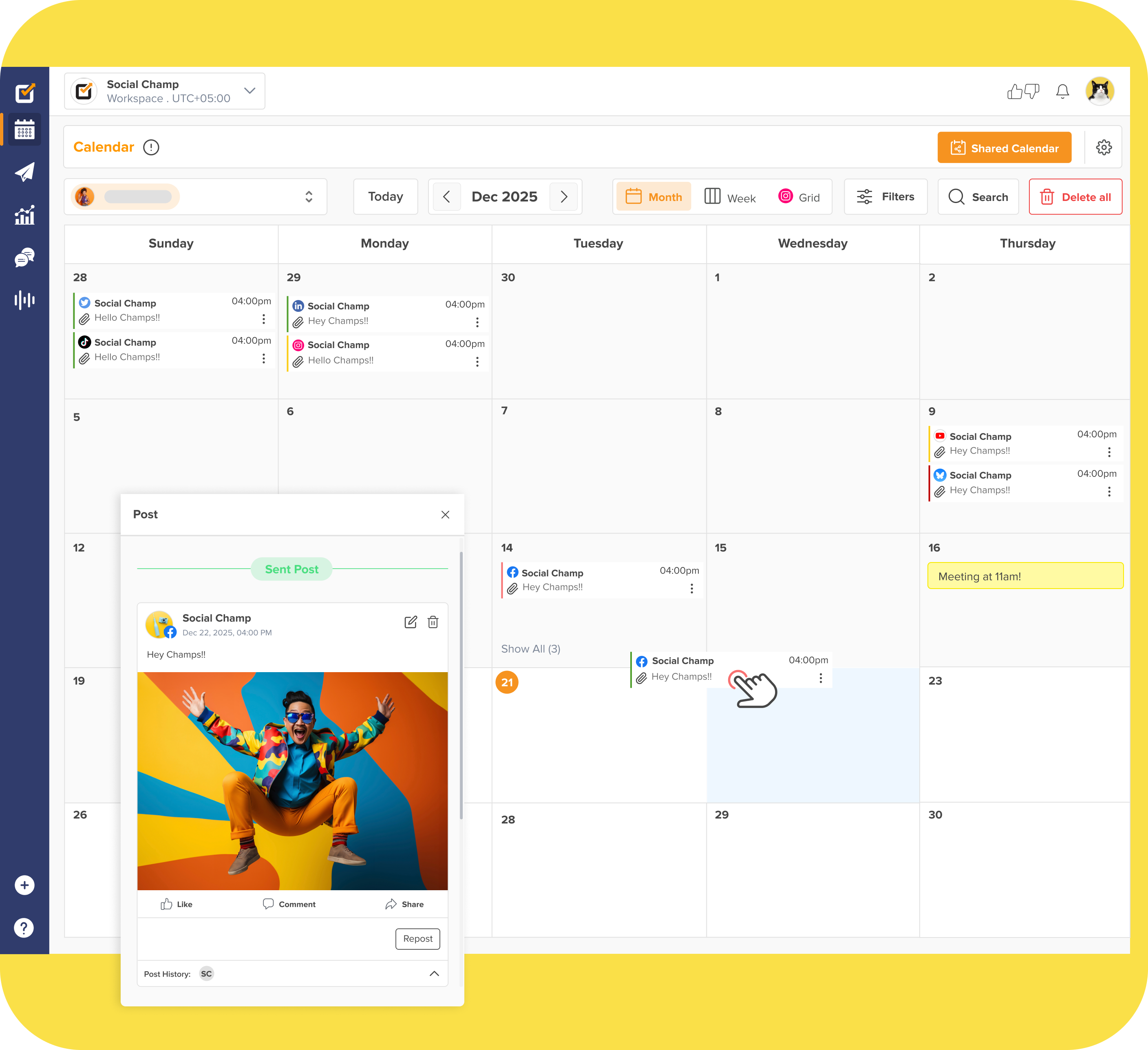
Why Waste Hours When You Can Automate in Minutes?
Plan, schedule, and publish across multiple platforms from one dashboard. Use Social Champ to cut manual work and stay consistently active 24/7.
Short Summary
- Social media scheduling tools are game-changers for businesses in 2025, saving hours of manual work while keeping your brand active and consistent 24/7.
- Automated posting doesn’t just save time; it dramatically boosts brand visibility, engagement, and marketing performance across every platform.
- Social Champ stands out as the ultimate all-in-one solution, offering unbeatable value, rich features, and scalability for businesses of all sizes.
- From Hootsuite to Buffer, Later, Sprout Social, and more, we’ve reviewed the most powerful tools trusted by marketers worldwide.
- Look for top-tier features like AI-powered automation, deep analytics, seamless team collaboration, and full support for all major social platforms.
- Smart brands plan ahead using content calendars, engaging with audiences in real time, and analyzing what works to stay ahead of the competition.
Why Businesses Need Social Media Scheduling Tools in 2025
In the fast-evolving digital marketing space of 2025, maintaining a strong presence on social media is not optional; it’s essential.
Whether you’re a small local startup or a global enterprise, your social media platforms are where customers engage with your brand, learn about your offerings, and form long-lasting impressions.
However, this consistent visibility requires more than just occasional posting; it demands strategy, timing, and automation.
This is where social media scheduling tools for business play a pivotal role.
The Burden of Manual Posting
Running a business means juggling multiple tasks like product development, customer support, marketing, and more.
Trying to post manually on platforms like Facebook, Instagram, X (formerly Twitter), LinkedIn, TikTok, or YouTube becomes time-consuming and inconsistent.
Businesses that rely solely on manual posting often experience burnout or lapses in content quality and frequency.
A social media posting schedule for business allows you to batch-create content in advance, automate the publishing process, and maintain a professional online presence even when your team is busy with other operations.
Automation Saves Time and Increases Output
One of the most compelling reasons businesses turn to scheduling tools is the immense time-saving potential.
Rather than logging into multiple platforms every day, a business can use a central dashboard to plan, create, and schedule posts for the entire week or even the whole month.
Tools like Social Champ, Buffer, and Hootsuite offer multi-platform scheduling, allowing users to queue content across Facebook, Twitter X, Instagram, LinkedIn, and even TikTok and Pinterest.
This efficiency doesn’t just save hours; it boosts overall productivity.
Marketing teams can focus more on content quality, trend analysis, community engagement, and performance monitoring rather than getting bogged down with repetitive tasks.
Enhancing Brand Consistency Across Channels
Another major advantage of using business social media tools is maintaining a consistent brand voice across various channels.
When different team members are responsible for posting on different platforms at different times, brand messaging can become disjointed or confusing.
Social media scheduling tools come equipped with features like editorial calendars, brand asset libraries, and post previews, ensuring that tone, visual style, and campaign goals are unified across the board.
Consistency isn’t just about aesthetics; it builds trust.
When audiences see regular, professional posts from your business, they’re more likely to engage, follow, and convert into customers.
Strategic Planning and Performance Analysis
In 2025, social media marketing is no longer a game of guesswork.
Most scheduling tools now come with built-in analytics dashboards, allowing businesses to make data-driven decisions.
For example, Social Champ provides in-depth reports on engagement rates, best posting times, audience demographics, and more.
By analyzing which posts perform best, you can refine your content strategy over time.
Instead of blindly pushing out content, you’re continuously optimizing for impact.
You’ll also be able to track key performance indicators (KPIs) such as reach, click-through rate (CTR), follower growth, and ROI, all from within your scheduling tool.
Scaling Teams and Workflows
For growing businesses and marketing agencies, collaboration becomes a major concern.
Who’s creating the content? Who’s approving it? Who’s responsible for publishing it?
Without a clear system, tasks fall through the cracks.
This is where tools like Planable, Loomly, and Later shine.
These platforms offer collaboration-friendly features such as internal comments, approval workflows, version control, and user roles.
This not only boosts productivity but also ensures that every piece of content reflects the company’s standards.
Agencies managing multiple clients can easily switch between accounts without risking cross-posting errors or breaches in confidentiality.
Engaging at the Right Time, Every Time
Another benefit of scheduling tools is posting at optimal times.
Studies show that engagement rates vary depending on the time of day and the day of the week.
Scheduling software often provides AI-powered suggestions based on audience behavior.
For example, Social Champ analyzes past performance data to recommend high-impact time slots.
This kind of intelligent automation ensures that your content reaches users when they’re most active, increasing the chances of engagement, shares, and conversions.
Managing Multiple Platforms From One Dashboard
In 2025, businesses typically operate on more than one platform.
Managing posts, messages, and analytics separately for each one becomes overwhelming.
A social media management tool for small businesses solves this by centralizing everything in one interface.
Whether it’s scheduling Instagram stories, replying to LinkedIn messages, or monitoring YouTube comments, these tasks can be handled through a single dashboard.
This level of integration streamlines workflows and minimizes the chances of oversight.
Crisis Management and Queue Flexibility
Another underrated benefit is the ability to pause or adjust your content queue in times of crisis or breaking news.
If a global event happens or a campaign needs to be paused due to unforeseen circumstances, you can quickly halt all scheduled posts with a single click.
Tools like Hootsuite and Agorapulse provide queue control and flexible scheduling options so that businesses stay agile and responsive.
Cost Efficiency and ROI
Most social media software for business platforms offers pricing tiers based on team size, feature access, and number of connected accounts.
For small businesses, entry-level plans are often enough to cover their needs, especially with tools like Social Champ, which offer full functionality at a fraction of the cost of enterprise software like Sprout Social.
In the long term, investing in a scheduling tool leads to better time management, improved engagement, and clearer insights, all of which translate to a stronger return on investment.
Top Social Media Scheduling Tools (Comparison Overview)
When evaluating the best social media scheduling tools in 2025, it’s essential to compare the leading options side by side.
The market is full of powerful platforms, but not all tools are created equal.
Each business has unique needs depending on its size, audience, budget, and strategy.
This section provides a concise yet thorough comparison of the top five social media scheduling tools for business, helping you decide which is right for your brand.
| Tool | Best For | Starting Price | Platforms Supported |
| Social Champ | Affordability & Scalability | $4/month | Facebook, X (Twitter), Instagram, LinkedIn, TikTok, YouTube, WhatsApp Business, Threads, Bluesky, Mastodon, Pinterest, and Google Business Profile |
| Hootsuite | Community Interaction | $99/month | Facebook, X (Twitter), Instagram, LinkedIn, TikTok, YouTube, Threads, and Pinterest |
| Buffer | Simplicity & Clean UI | $5/month | Facebook, X (Twitter), Instagram, LinkedIn, TikTok, YouTube, WhatsApp Business, Threads, Bluesky, Mastodon, and Pinterest |
| Sprout Social | Comprehensive Scheduling | $199/month | Facebook, X (Twitter), Instagram, LinkedIn, TikTok, YouTube, WhatsApp, Threads, Facebook Messenger, Reddit, Tumblr, Web, and Pinterest |
| SocialPilot | Agency-Level Management | $25.50/month | Facebook, X (Twitter), Instagram, LinkedIn, TikTok, YouTube, WhatsApp Business, Threads, Bluesky, Pinterest, and Google Business Profile |
These tools were selected based on feature depth, pricing flexibility, and ease of use. Below is a breakdown of what makes each stand out, with a fair look at both strengths and drawbacks.

Bulk It Like a Pro
Upload and schedule hundreds of posts in one go with Social Champ’s CSV and bulk scheduler—no repetitive clicks required.
15 Best Social Media Scheduling Tools for Business (With Pros & Cons)
| Tool | Starting Price | Platforms Supported | Standout Feature | Best Fit For |
| Social Champ | $4/month | Facebook, X (Twitter), Instagram, LinkedIn, TikTok, YouTube, WhatsApp Business, Threads, Bluesky, Mastodon, Pinterest, and Google Business Profile | AI captioning, sentiment analysis | Small to mid-sized businesses |
| Hootsuite | $99/month | Facebook, X (Twitter), Instagram, LinkedIn, TikTok, YouTube, Threads, and Pinterest | Unified social inbox | Enterprise teams, support-heavy brands |
| Buffer | $5/month | Facebook, X (Twitter), Instagram, LinkedIn, TikTok, YouTube, WhatsApp Business, Threads, Bluesky, Mastodon, and Pinterest | Clean UI, link-in-bio builder | Creators and small teams |
| Sprout Social | $199/month | Facebook, X (Twitter), Instagram, LinkedIn, TikTok, YouTube, WhatsApp, Threads, Facebook | Social CRM and deep analytics | Enterprises, multi-department teams |
| SocialPilot | $25.50/month | Facebook, X (Twitter), Instagram, LinkedIn, TikTok, YouTube, WhatsApp Business, Threads, Bluesky, Pinterest, and Google Business Profile | White-label client dashboards | Agencies and consultants |
| Later | $16.67/month | Facebook, X (Twitter), Instagram, LinkedIn, TikTok, YouTube, Threads, Snapchat, Pinterest, and Google Business Profile | Visual post planner, Linkin.bio | Visual-first brands, e-commerce |
| Planable | $33/user/month | Facebook, X (Twitter), Instagram, LinkedIn, TikTok, YouTube, Threads, Pinterest, and Google Business Profile | Real-time feedback and approvals | Agencies, remote teams |
| CoSchedule | $19/user/month | Facebook, X (Twitter), Instagram, LinkedIn, TikTok, YouTube, Threads, Bluesky, Mastodon, Pinterest, and Google Business Profile | Unified content + social calendar | Content-heavy marketing teams |
| Sendible | $29/month | Facebook, Instagram, X, LinkedIn, Google Business Profile, WordPress, YouTube, Pinterest, Threads, and Bluesky | Brand monitoring + blogging support | Agencies managing diverse clients |
| Loomly | custom | Facebook, Instagram, X, LinkedIn, Google Business Profile, YouTube, Pinterest, Threads, and Bluesky | Content inspiration + post tips | Small marketing teams |
| MeetEdgar | $24.91/month | Facebook, Instagram, X, LinkedIn, Google Business Profile, Pinterest, Threads, and Bluesky | Evergreen content recycling | Thought leaders, info brands |
| Zoho Social | $63.20/month | Facebook, X (Twitter), Instagram, LinkedIn, TikTok, YouTube, Threads, Bluesky, Mastodon, Pinterest, and Google Business Profile | Zoho CRM integration | Zoho users, small- to medium-sized businesses |
| Kontentino | €49/month | Facebook, X (Twitter), Instagram, LinkedIn, TikTok, Threads, Pinterest, and Google Business Profile | Visual previews + budget tracking | Client-facing agencies |
| Publer | $5/month | Facebook, X (Twitter), Instagram, LinkedIn, TikTok, YouTube, WhatsApp Business, Threads, Telegram, WordPress, Bluesky, Mastodon, Pinterest, and Google Business Profile | Post auto-delete + AI writing assistant | Creators, small businesses |
| ContentStudio | $19/month | Facebook, X (Twitter), Instagram, LinkedIn, TikTok, YouTube, WordPress, Threads, Bluesky, Pinterest, and Google Business Profile | Content curation + unified inbox | Content-driven teams and agencies |
-
Social Champ
Social Champ brings together automation, analytics, and AI, without the steep price tag most competitors charge.
Designed with both beginners and power users in mind, it offers a streamlined dashboard where users can manage posts across Facebook, X (Twitter), Instagram, LinkedIn, TikTok, YouTube, WhatsApp Business, Threads, Bluesky, Mastodon, Pinterest, and Google Business Profile.
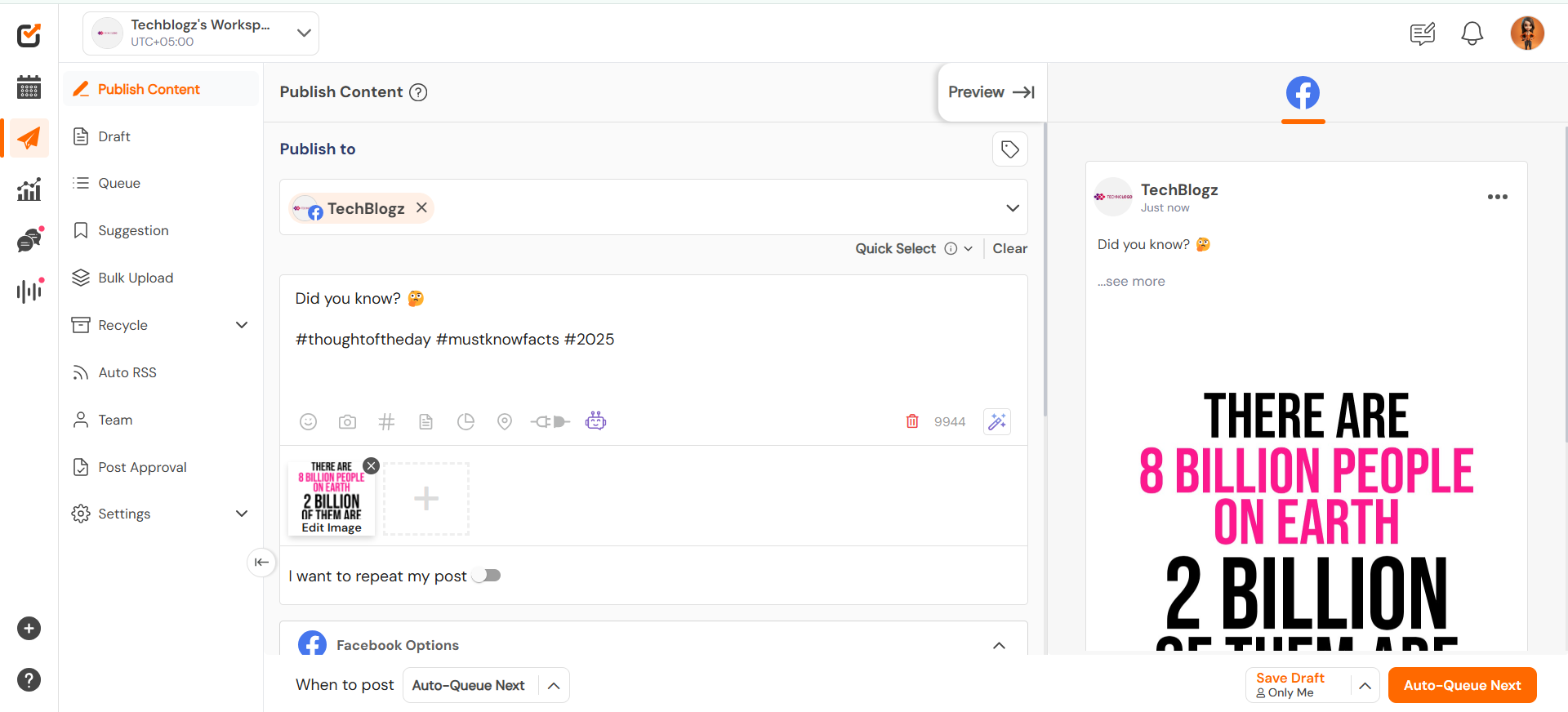
Social Champ’s Dashboard Key Features
- AI-powered caption generator & sentiment analysis
- Multi-platform scheduling, including Reels & Shorts
- Team collaboration with role-based access
- Bulk uploads and recurring queues
- Integrated analytics with exportable reports
Pros
✔ Highly affordable with robust features
✔ Smooth learning curve and user-friendly UI
✔ Strong analytics and approval workflows
✔ Excellent for small teams and agencies
Cons
✘ Limited third-party integrations beyond core platforms
✘ Some advanced analytics require premium plans
-
Hootsuite
Hootsuite offers everything from post planning to real-time engagement tracking.
Its strength lies in its social inbox, which aggregates messages and comments from multiple platforms so that teams can manage communication in one place.
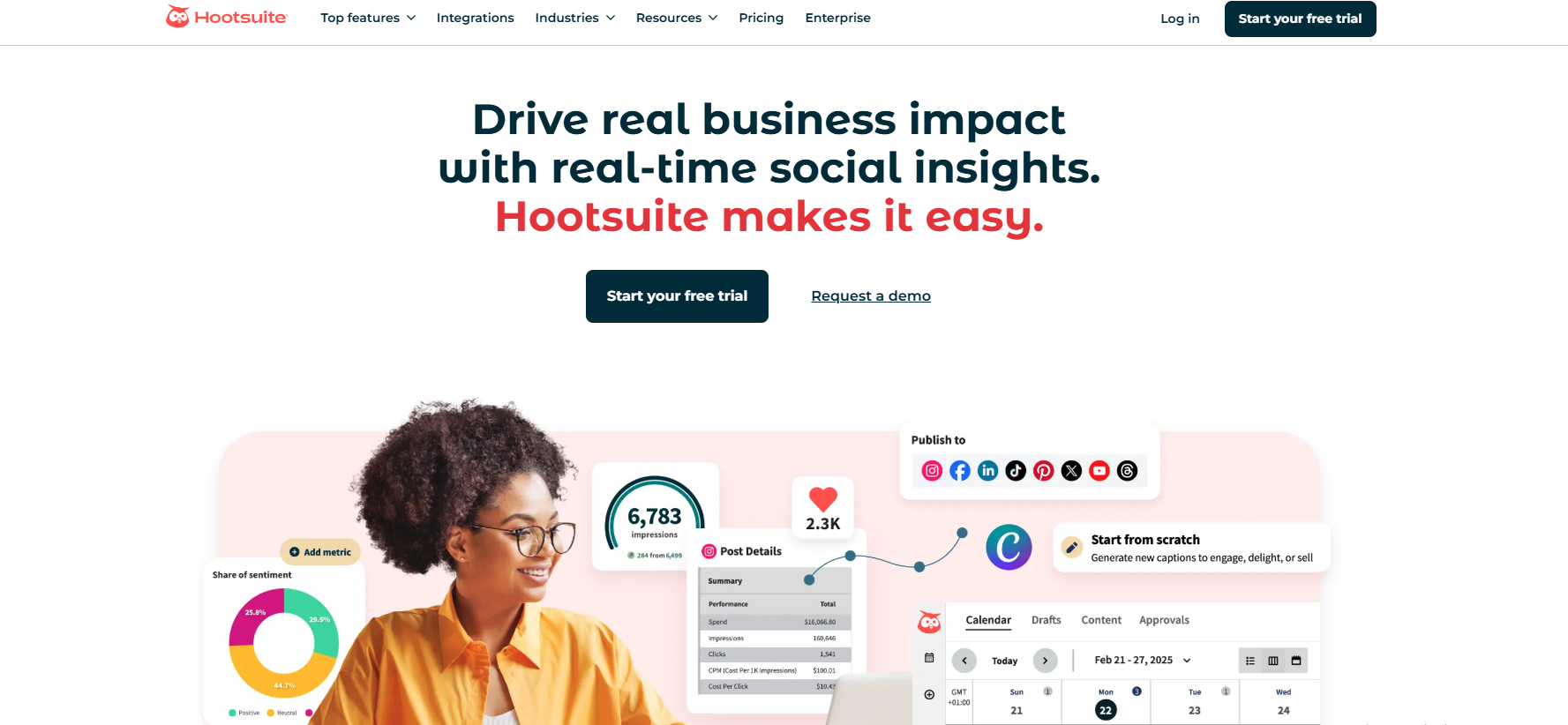
Hootsuite’s Landing Page Key Features
- Smart Inbox for DMs and comments
- 150+ third-party integrations
- Auto-scheduling with time optimization
- Campaign tagging and post tracking
- Robust analytics and team permissions
Pros
✔ Excellent for managing conversations at scale
✔ Deep analytics and audience insights
✔ Rich ecosystem of integrations
✔ Great support for multi-user workflows
Cons
✘ High entry-level cost ($99/month)
✘ The interface can feel cluttered for new users
-
Buffer
Buffer is particularly well-suited for straightforward scheduling and post-performance tracking.
Focused on clean design and efficiency, it’s a favorite among individual creators and small teams who don’t need the bulk of enterprise features.
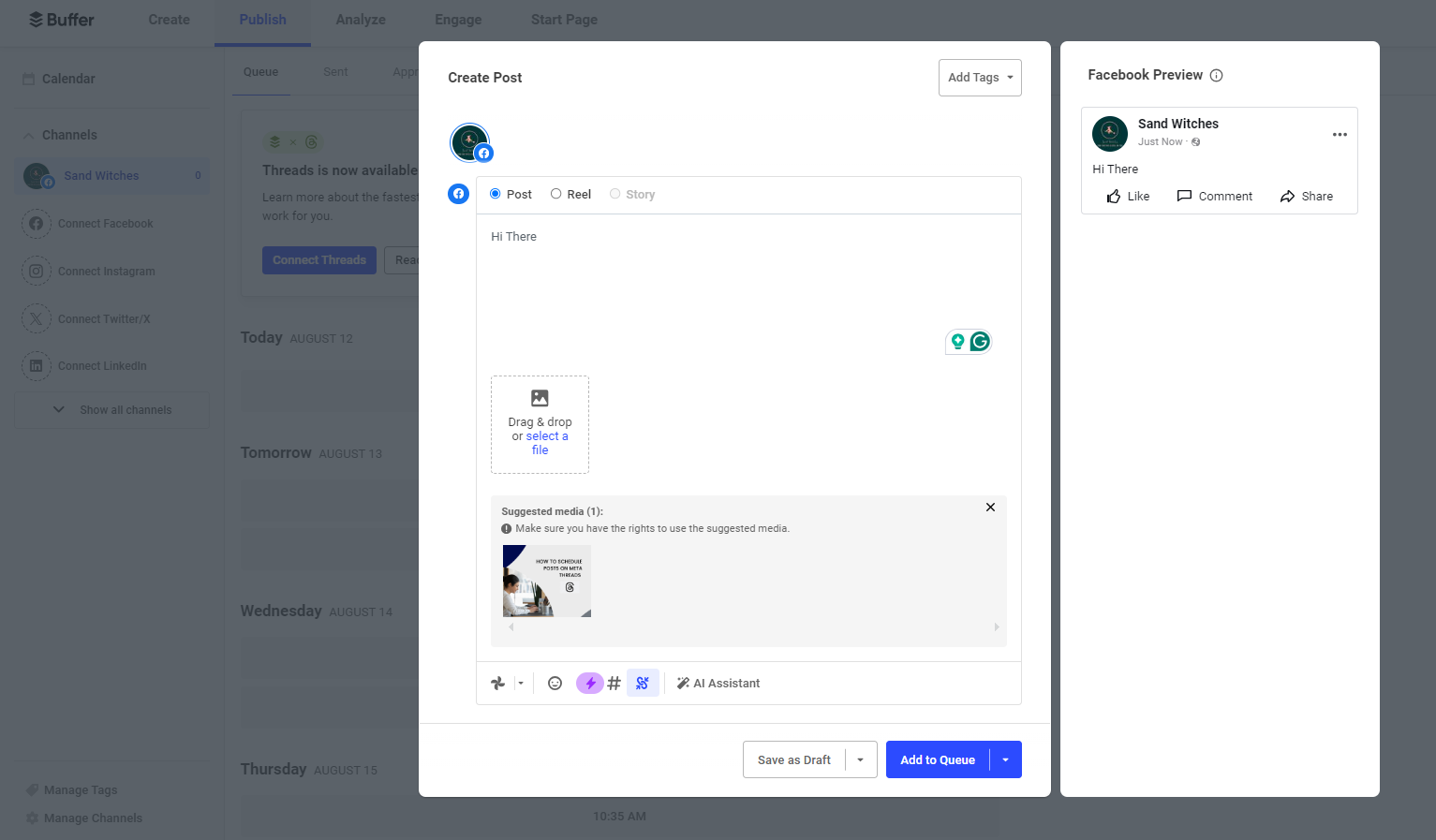
Buffer’s Dashboard Key Features
- Queue-based post scheduling
- Engagement and reach analytics
- Browser extension and mobile app
- Link-in-bio page creation
- Team collaboration (limited in the free plan)
Pros
✔ Extremely easy to use
✔ Affordable pricing tiers
✔ Good mobile support
✔ Ideal for freelancers and creators
Cons
✘ No inbox or message management
✘ Collaboration tools are limited on the basic plans
-
Sprout Social
Sprout Social offers one of the most comprehensive social media platforms available, but it comes with a price. Built with enterprises and large marketing teams in mind, Sprout combines publishing, engagement, social listening, and customer relationship management into one sleek interface.
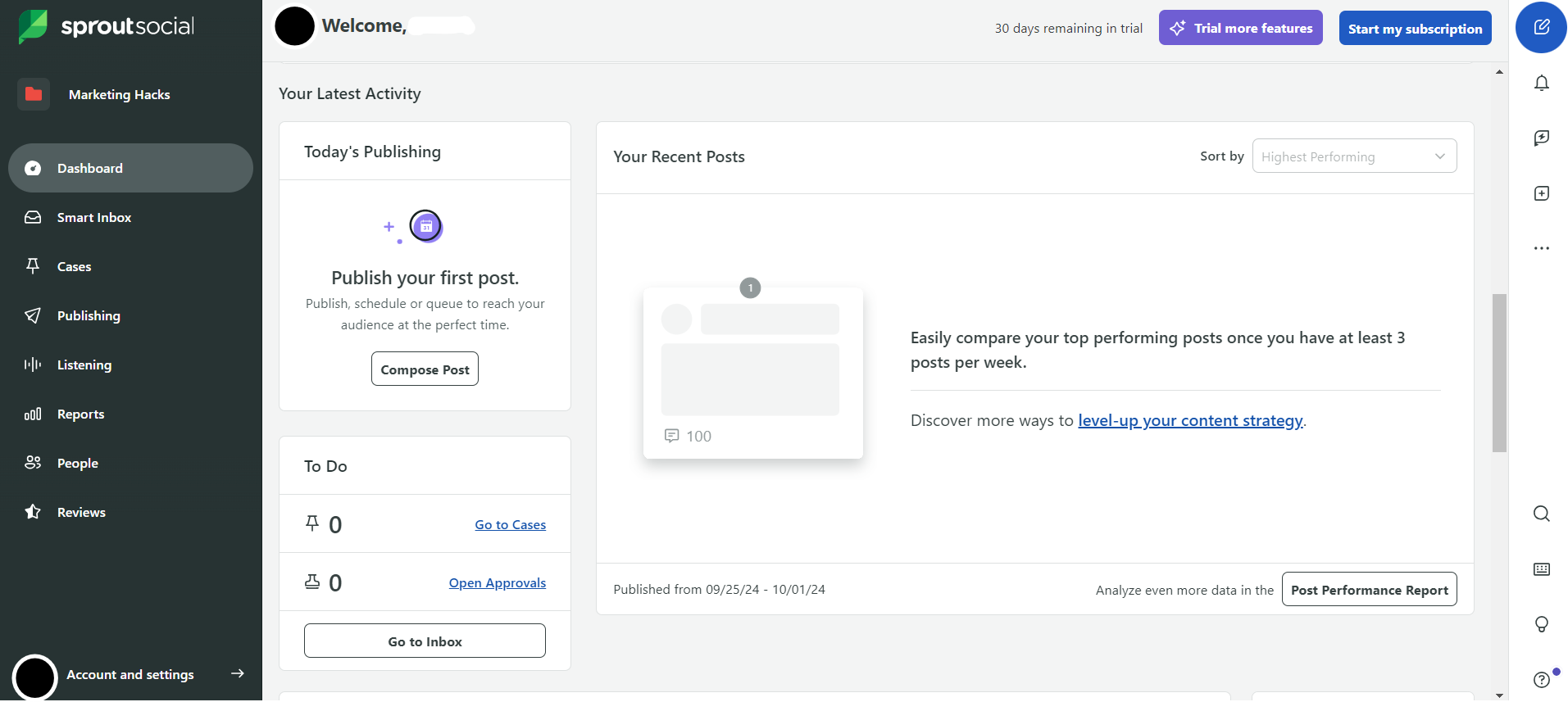
Sprout Social’s Dashboard Key Features
- Unified Smart Inbox
- CRM integration and conversation tagging
- Deep analytics with trend and audience insights
- Social listening and sentiment tracking
- Approval workflows for large teams
Pros
✔ Extremely powerful reporting and analytics
✔ CRM and listening tools in one place
✔ Highly scalable for large organizations
✔ Built-in publishing and approval systems
Cons
✘ High pricing starts at $249/month
✘ Learning curve for smaller teams
-
SocialPilot
SocialPilot is built for consultants, freelancers, and small marketing teams managing multiple clients.
The platform supports white-label reporting, bulk scheduling, and client dashboards.
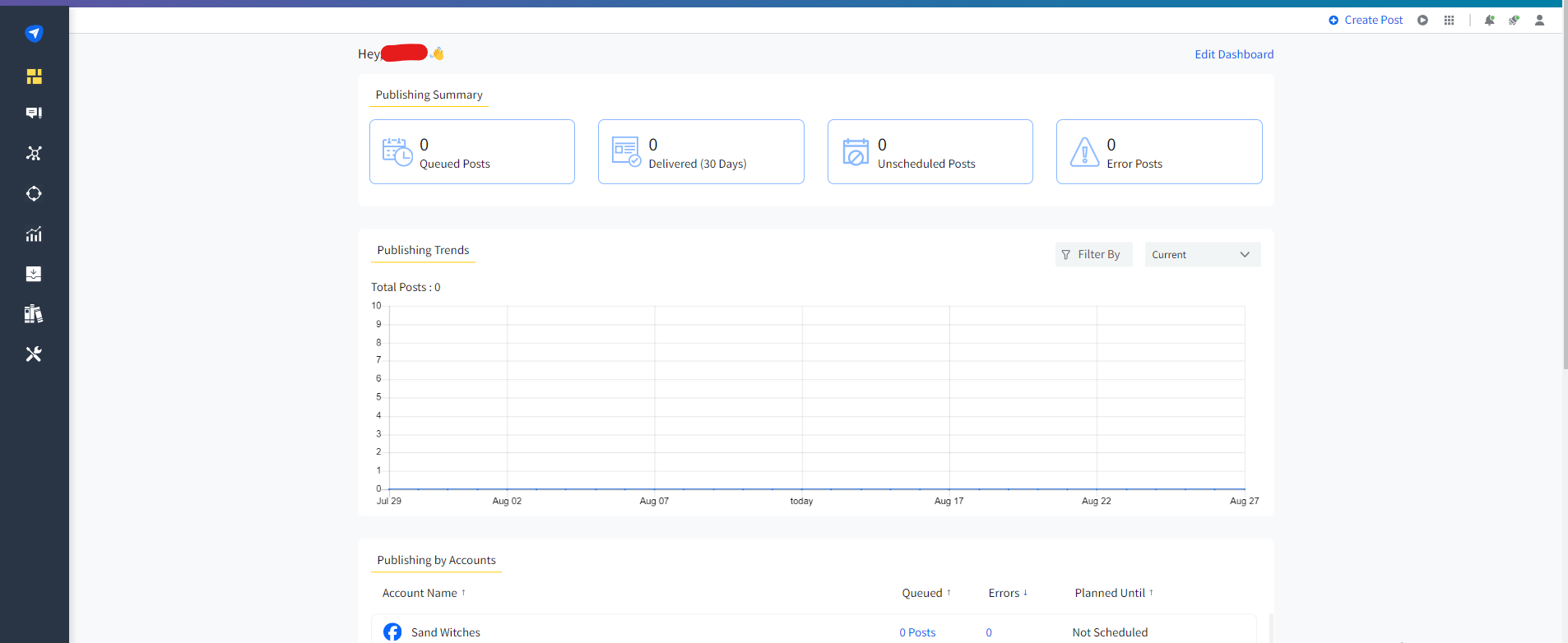
SocialPilot’s Dashboard Key Features
- Bulk scheduling and RSS feed automation
- Client dashboard with white-label reporting
- Calendar-based post planning
- URL shortening and UTM tagging
- Analytics for individual and grouped accounts
Pros
✔ Excellent value for agencies
✔ High limits on posts and users
✔ Supports team and client workflows
✔ White-labeling available
Cons
✘ The interface lacks modern design
✘ No inbox or real-time engagement tools
-
Later
Later focuses on visual-first platforms like Instagram, TikTok, and Pinterest, making it the go-to for ecommerce brands, fashion retailers, and lifestyle influencers.
It offers an intuitive drag-and-drop calendar, allowing users to preview how posts will look in a feed before scheduling.
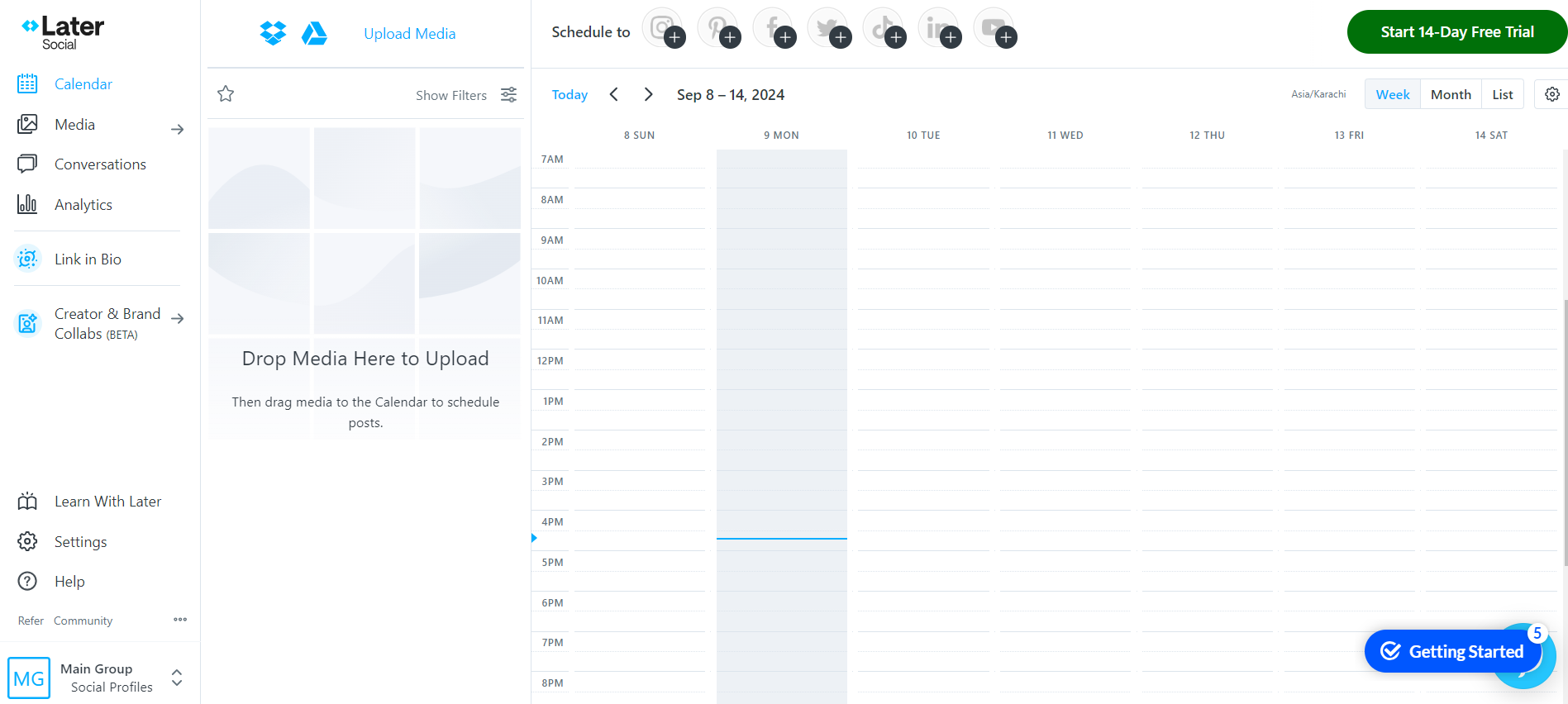
Later’s Dashboard Key Features
- Visual content calendar
- Instagram Reels and TikTok auto-publishing
- Linkin.bio landing page
- Hashtag suggestions and post analytics
- Content curation tools
Pros
✔ Ideal for visually-driven brands
✔ Easy-to-use drag-and-drop interface
✔ Integrated link-in-bio tool
✔ Competitive pricing for core features
Cons
✘ Limited support for LinkedIn and YouTube
✘ Analytics and collaboration are gated behind higher plans
-
Planable
Planable is designed for teams that prioritize collaboration and content approval.
Marketers can visually draft posts, share them with teammates or clients for feedback, and track changes in a versioned history.
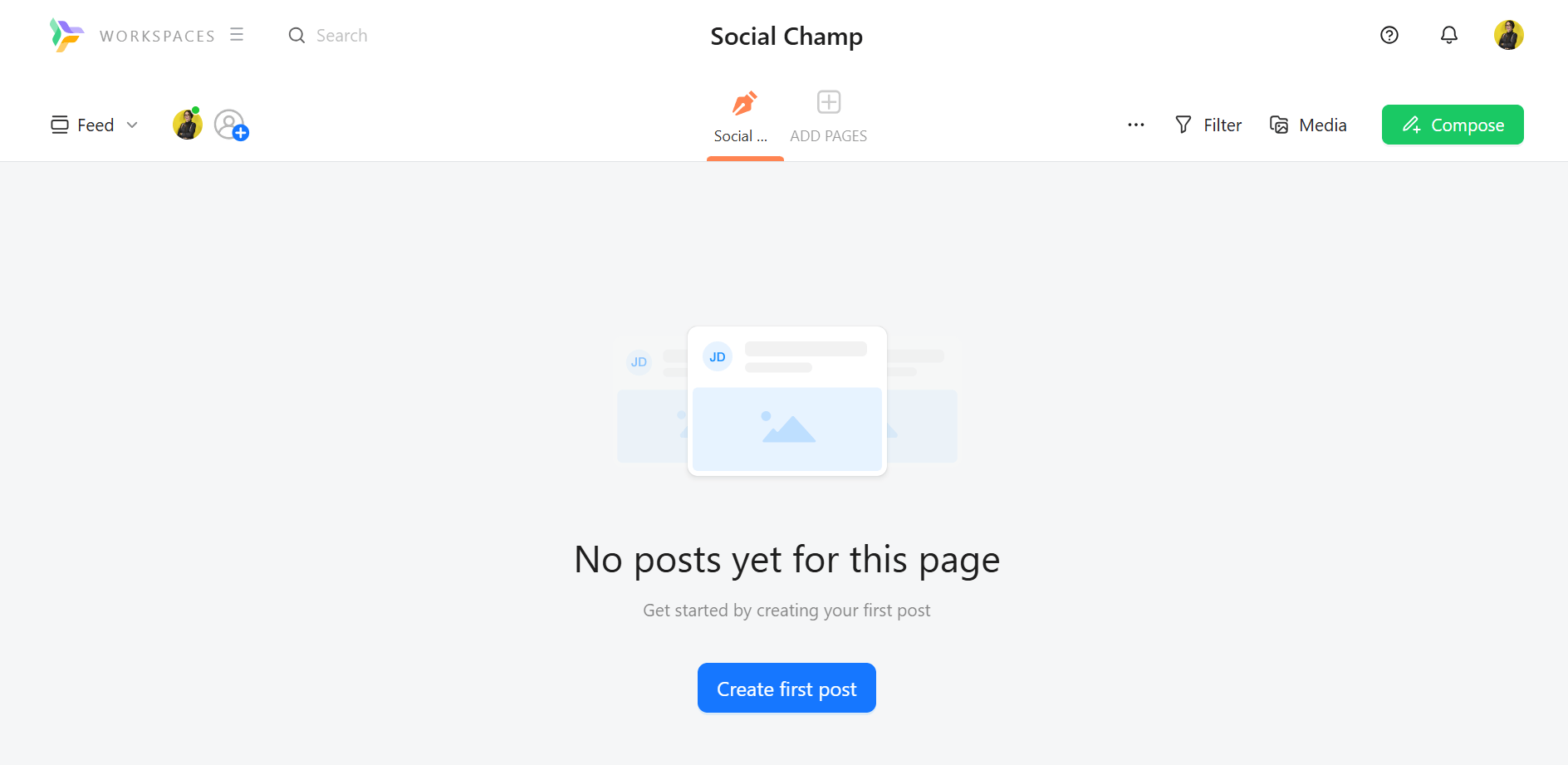
Planable Dashboard Key Features
- Visual content calendar with real-time previews
- Internal commenting and feedback threads
- Post versioning and approval workflows
- Media library for shared assets
- Support for carousels, stories, and Reels
Pros
✔ Streamlines approvals and client feedback
✔ Easy to onboard non-technical users
✔ Reduces back-and-forth on post edits
✔ Great for remote and cross-functional teams
Cons
✘ Limited publishing automation
✘ Lacks in-depth analytics or engagement features
-
CoSchedule
CoSchedule takes a broader approach by integrating social media scheduling with content marketing and campaign management.
It’s especially useful for companies that run blogs, newsletters, and social posts in tandem.
The unified calendar gives a bird’s-eye view of all campaigns, blog deadlines, and promotional posts in one place.
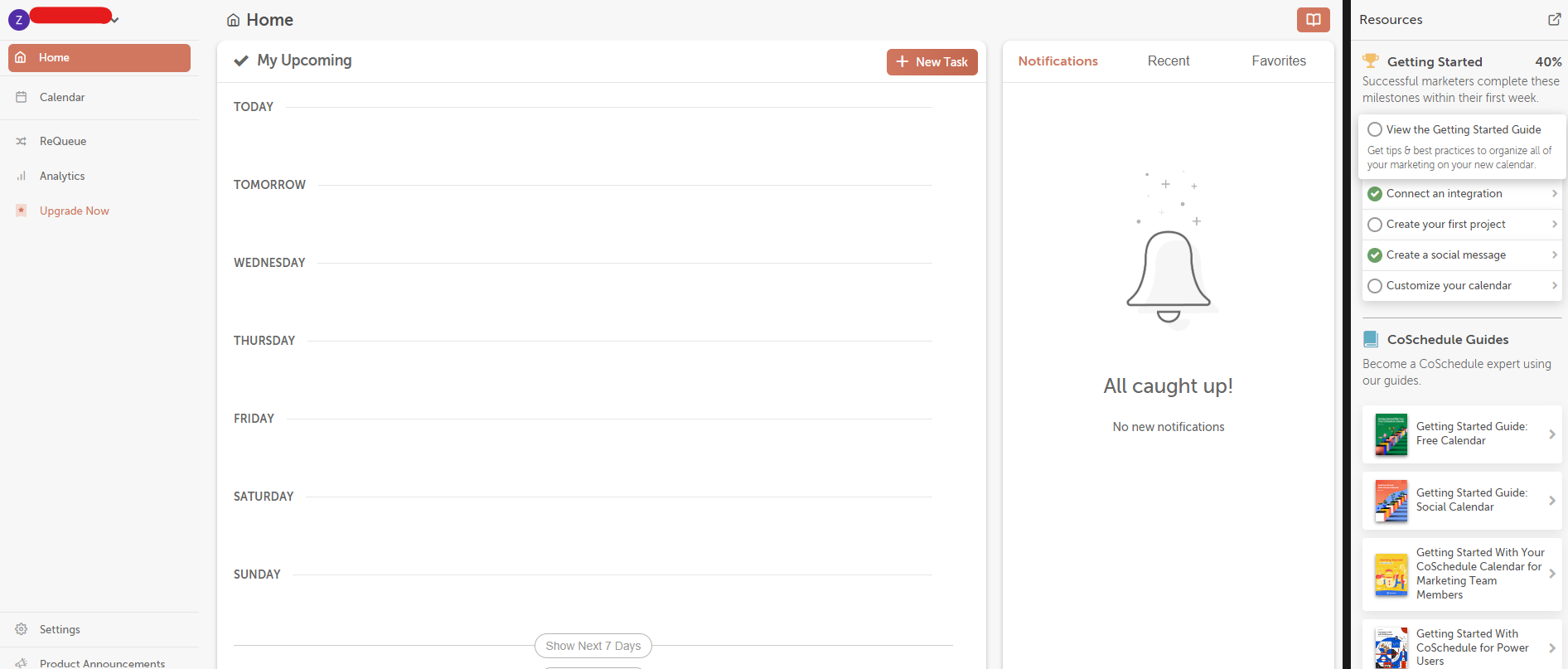
CoSchedule’s Dashboard Key Features
- Unified content and social calendar
- Task assignment for cross-team collaboration
- Social templates for campaign reuse
- WordPress and HubSpot integrations
- Headline analyzer and blog planning tools
Pros
✔ Excellent for aligning blog and social campaigns
✔ Built for structured marketing teams
✔ Saves time with reusable workflows
✔ Helps enforce brand timelines
Cons
✘ Not ideal for engagement or inbox management
✘ Analytics are basic compared to other platforms
-
Sendible
Sendible is built with digital agencies in mind.
It offers deep customization, white-label dashboards, and flexible reporting—all features that cater well to client-based workflows.
A major differentiator is its support for publishing to platforms like Google My Business and WordPress, in addition to social networks.
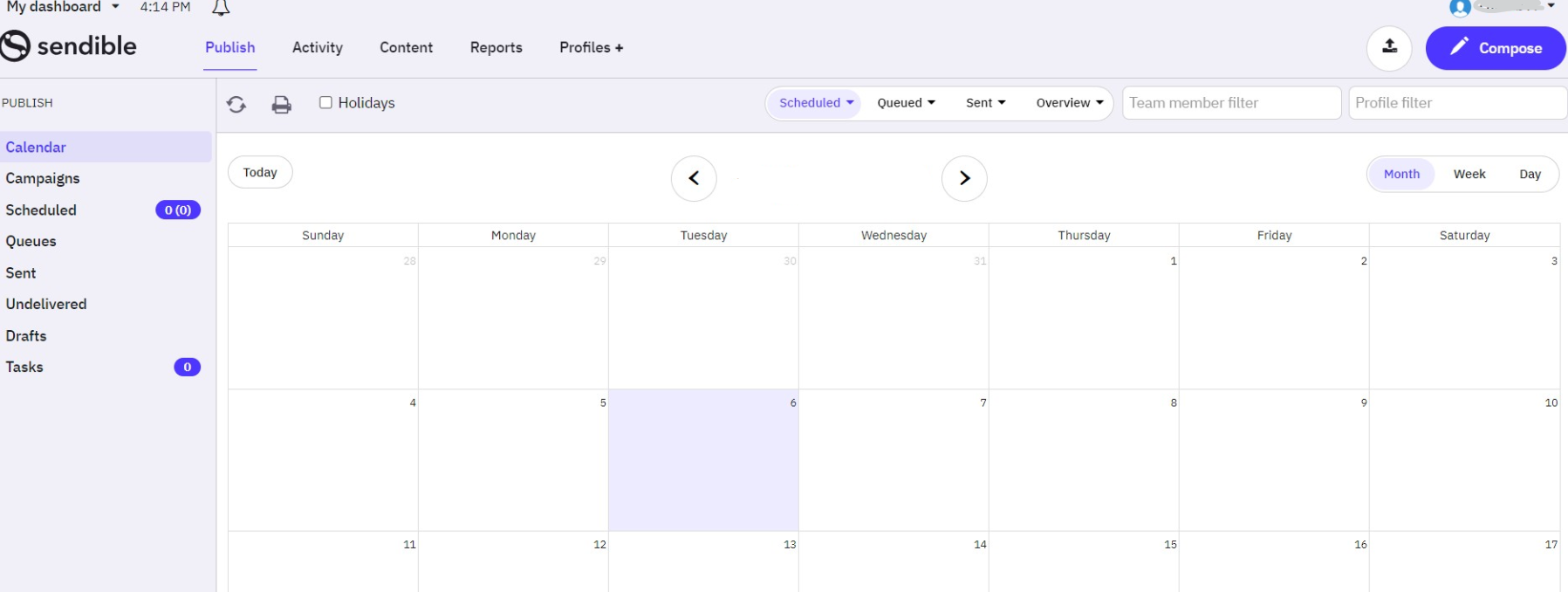
Sendible’s Dashboard Key Features
- Custom branding and white-label reports
- Content queues and scheduling automation
- Social listening and keyword alerts
- Integration with blogging platforms
- Client dashboards and permission settings
Pros
✔ Tailored for multi-client environments
✔ Strong reputation monitoring tools
✔ Customizable reporting for agencies
✔ Broad platform support, including blogs
Cons
✘ UI feels dated and less intuitive
✘It can get expensive with many clients or users
-
Loomly
Loomly appeals to smaller teams and solo marketers looking for a smarter, more guided approach to content scheduling.
Its strength lies in its post-building workflow, which prompts users with creative tips, format ideas, and post previews—great for users who need a little direction during planning.
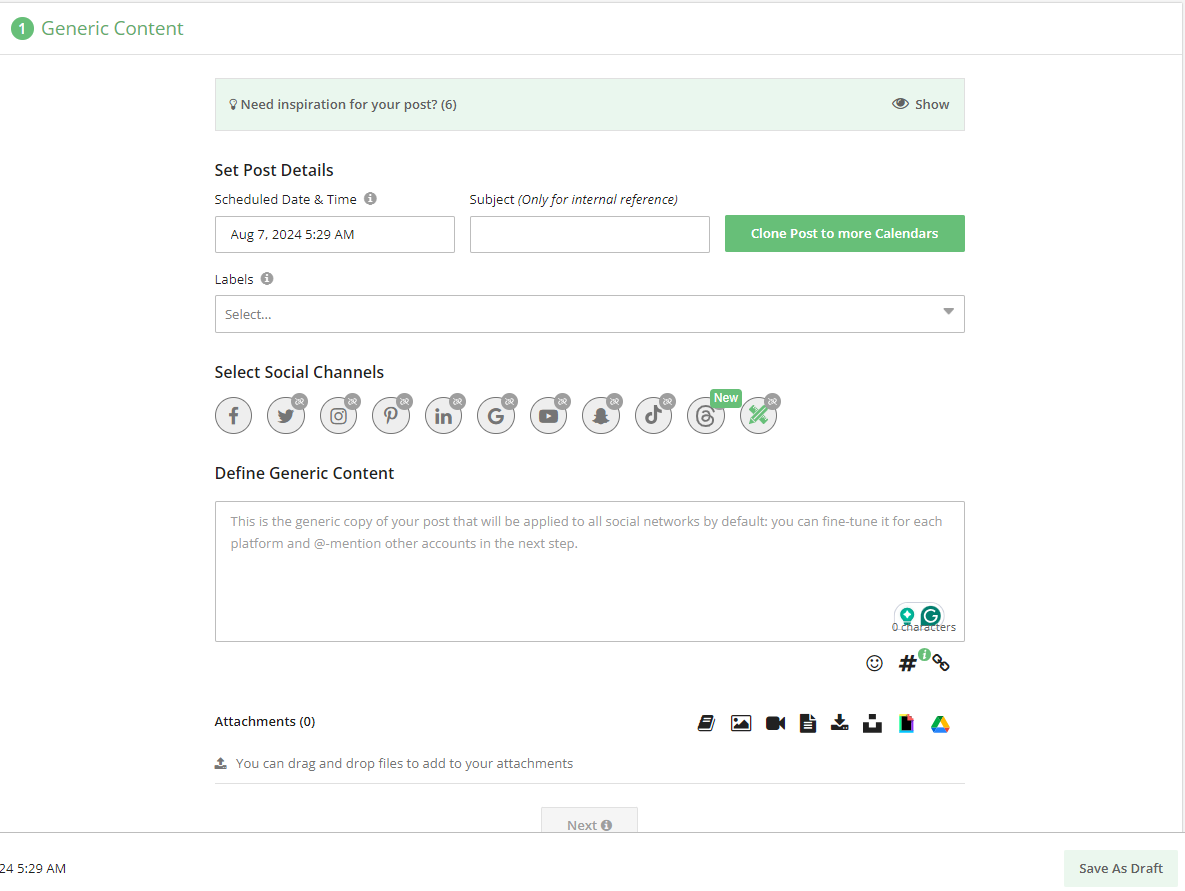
Loomly’s Dashboard Key Features
- Post ideas and optimization tips
- Collaboration and approval stages
- Performance analytics with post breakdowns
- Asset library and tagging system
- Facebook Ads manager integration
Pros
✔ Easy content ideation for beginners
✔ Helpful suggestions for improving posts
✔ Approval steps streamline teamwork
✔ Affordable pricing for most users
Cons
✘ Not suited for large or complex teams
✘ Engagement features are minimal
-
MeetEdgar
MeetEdgar is built around one powerful idea: evergreen automation.
Instead of creating new content constantly, it allows users to organize content libraries into categories and automate reposting.
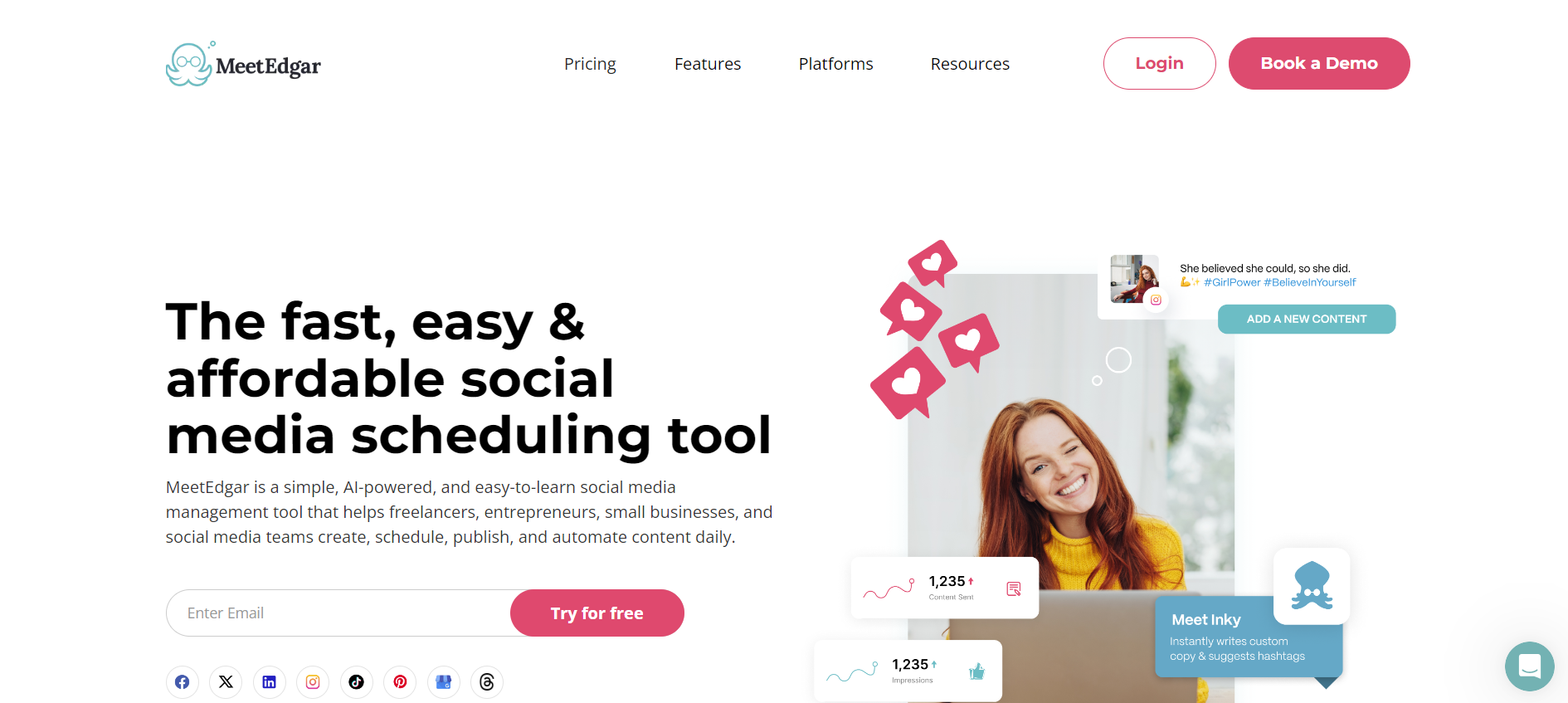
MeetEdgar Landing Page Key Features
- Content library with category tagging
- Automated post recycling
- Auto-generated post variations
- Queue-based publishing
- Simple performance reports
Pros
✔ Excellent for maximizing evergreen content
✔ Low-maintenance content pipelines
✔ Helps keep feeds full and active
✔ Saves time with auto-caption variations
Cons
✘ Not suitable for time-sensitive campaigns
✘ Doesn’t support engagement or listening
-
Zoho Social
Part of the broader Zoho ecosystem, Zoho Social offers solid publishing, analytics, and brand monitoring tools.
It integrates seamlessly with Zoho CRM, making it an ideal choice for businesses already using Zoho’s software stack.
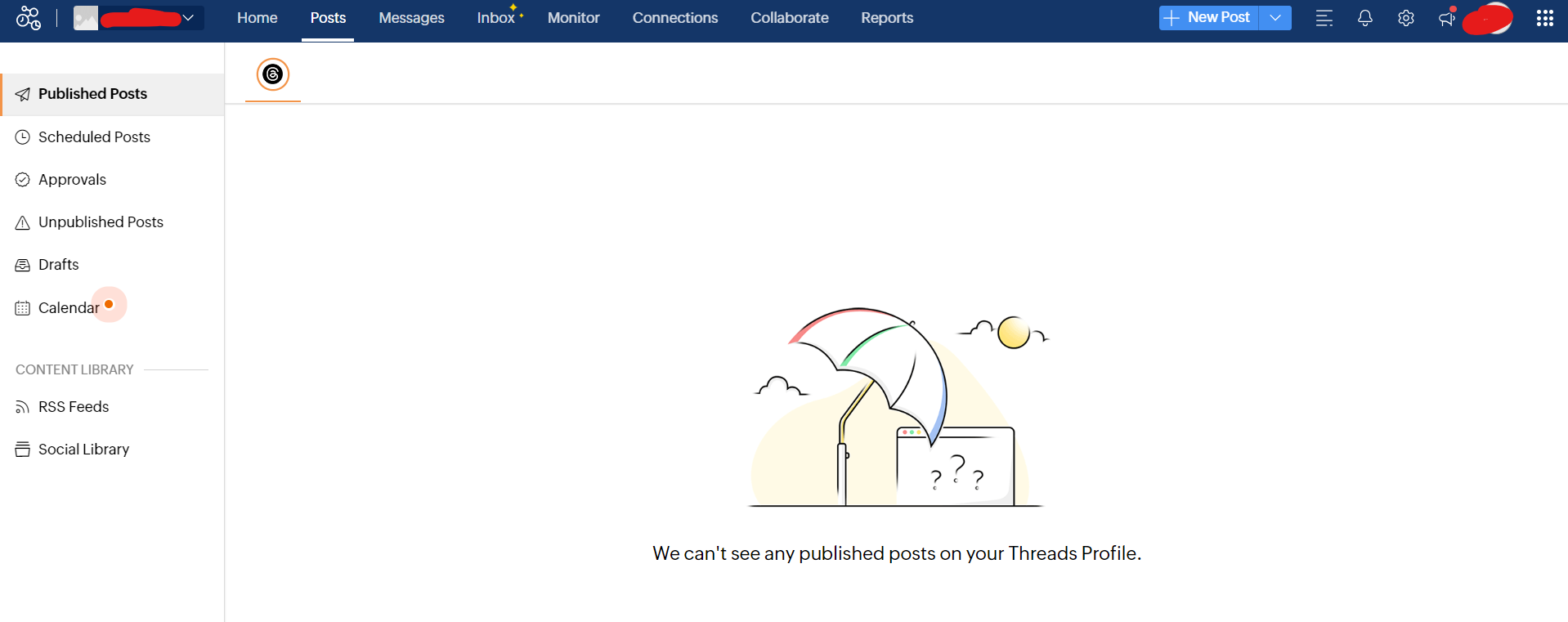
Zoho Social’s Dashboard Key Features
- Zoho CRM and Desk integration
- Keyword monitoring and social listening
- Scheduled publishing with calendar view
- Team roles and collaboration
- Analytics with customizable dashboards
Pros
✔ Great for Zoho users
✔ Affordable plans for SMBs
✔ Useful social listening features
✔ Integrates well across the Zoho suite
Cons
✘ UI is not as polished as competitors
✘ Analytics can be less intuitive
-
Kontentino
Kontentino is a collaboration-first tool designed for agencies and marketing teams that need precise planning and client approvals.
It puts emphasis on visuals, providing pixel-perfect previews and a clean timeline-based calendar that simplifies post scheduling and client discussions.

Kontentino’s Dashboard Key Features
- Collaborative visual calendar
- Client feedback and approval modules
- Campaign budget tracking
- Workflow history and post versioning
- Exportable performance reports
Pros
✔ Ideal for client-facing content planning
✔ Strong workflow and version control
✔ Helps reduce errors with real-time previews
✔ Transparent collaboration features
Cons
✘ Less powerful for automation
✘ Not useful for real-time engagement
-
Publer
Publer is one of the newer but increasingly popular players in the social scheduling arena.
It offers a mix of AI, bulk scheduling, and post-recycling that appeals to creators and growing businesses alike.
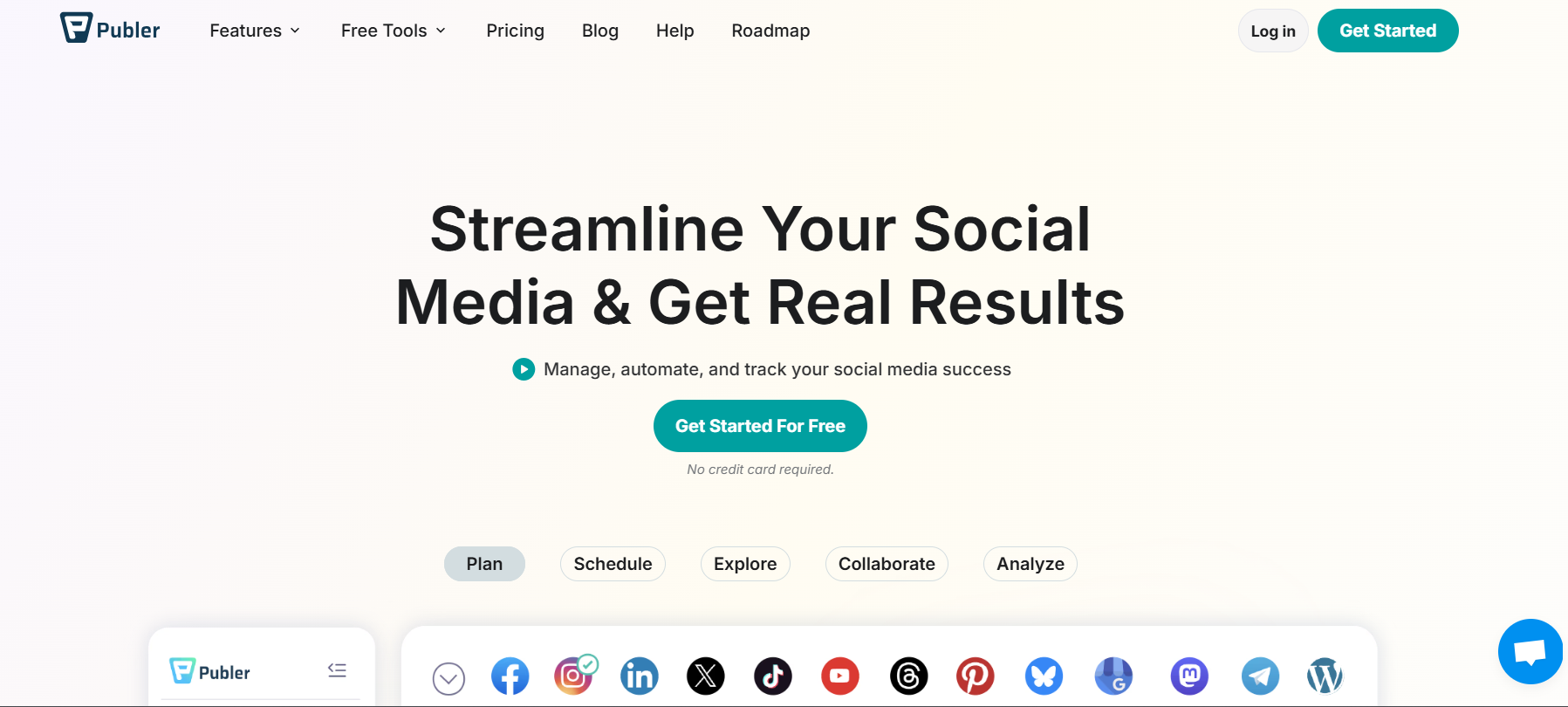
Publer’s Landing Page Key Features
- AI writing assistant for captions
- Post recycling and expiration features
- Bulk CSV upload and scheduling
- Link shorteners and UTM builder
- Canva and Unsplash integration
Pros
✔ Balanced tool with modern UX
✔ Great AI-powered features
✔ Strong media management
✔ Affordable pricing, including a generous free plan
Cons
✘ Lacks advanced analytics depth
✘ Limited support for team collaboration at base levels
-
ContentStudio
ContentStudio has emerged as a top-tier platform for businesses and marketers who want to combine smart scheduling with content discovery and analytics.
It’s especially valuable for brands that need to manage multiple platforms and curate industry-relevant content alongside their own campaigns.
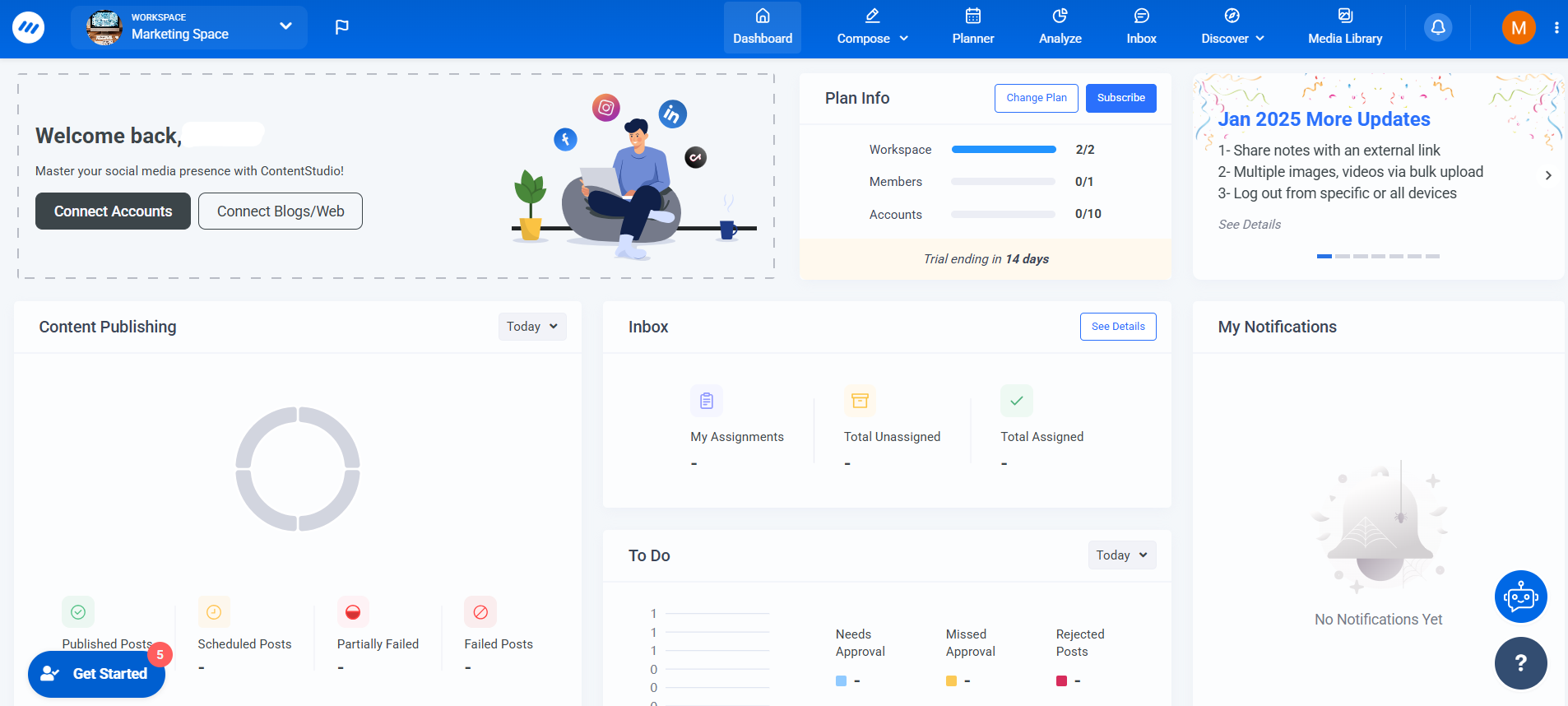
ContentStudio’s Dashboard Key Features
- Multi-platform publishing, including blogs and video channels
- AI-powered content discovery and automation
- Evergreen content recycling
- Unified social inbox for comments and DMs
- Team collaboration, approval workflows, and client workspaces
Pros
✔ Combines scheduling with content curation and discovery
✔ Great for agencies and content-heavy brands
✔ Deep analytics with white-label report options
✔ Unified inbox improves engagement management
Cons
✘ Slight learning curve for new users
✘ Some features are locked behind higher-tier plans
Featured Article: 10 Best Digital Marketing Platforms for 2025 – Boost Your Growth
Social Champ: The Most Affordable & Scalable Social Media Scheduling Tool for Businesses
Among the many social media scheduling tools available today, Social Champ stands out as a top choice for affordability, versatility, and ease of use.
Whether you’re a solo entrepreneur, a small business, or a growing team managing multiple clients, Social Champ offers a perfect balance of power and simplicity, without the high price tag.
Why Choose Social Champ?
-
Competitive Pricing for All Business Sizes
One of the biggest strengths of Social Champ is its accessible pricing.
With plans starting at just $4/month, it’s significantly more affordable than tools like Sprout Social or Hootsuite.
For startups, freelancers, and small marketing teams, this makes a real difference in maintaining a lean budget while still leveraging high-quality automation.
-
Complete Multi-Platform Integration
Unlike some tools that focus mainly on Instagram or Facebook, Social Champ offers native integration with virtually every major social media platform.
You can schedule, edit, preview, and analyze posts across all networks from a single dashboard, with no switching tabs or copying/pasting.
-
AI-Powered Features
Social Champ has introduced AI-powered caption generation and smart content suggestions to help users create engaging posts faster.
This is particularly helpful for busy marketers who need fresh content regularly but don’t always have time to write from scratch.
It also includes a recycle feature that allows evergreen content to be reused automatically, maximizing reach without extra effort.
-
Advanced Analytics & Reporting
The platform features a user-friendly analytics dashboard that provides real-time performance data for each post and platform.
Users can track key metrics like engagement rate, reach, impressions, clicks, and follower growth.
Reports can be downloaded or shared with stakeholders, making it easy to present ROI or adjust strategy based on actual results.
-
Bulk Scheduling and Automation
Users can schedule weeks of content in advance using CSV imports, bulk upload features, and calendar view.
Automation options include time-slot presets, queuing, and repeat scheduling.
This is ideal for businesses that want to maintain a steady content pipeline while focusing on other aspects of their operations.
-
Collaboration Tools for Teams
Social Champ supports role-based access, allowing teams to collaborate without risking accidental changes or overlaps.
Each team member can be assigned specific roles like admin, editor, or client, ensuring workflow control and accountability.
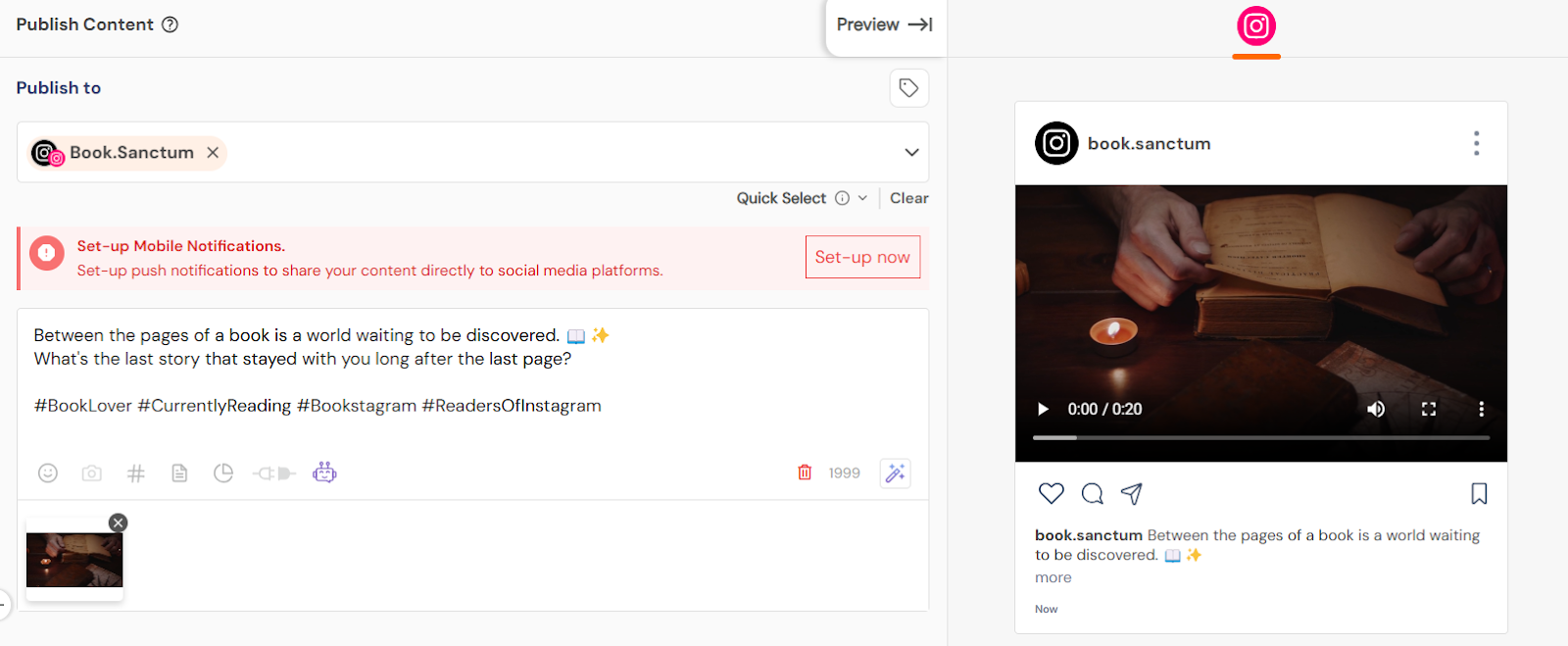

Tired of Copy-Pasting Across Platforms?
Social Champs lets you schedule once and publish everywhere—Facebook, X, LinkedIn, Instagram, TikTok, YouTube, and more from one unified tool.
How to Pick the Right Social Media Software for Your Business
With so many tools available in 2025, choosing the right social media scheduling tool for business can feel overwhelming.
Each platform offers a different combination of features, integrations, and pricing models.
To help you navigate your options, here’s a decision-making framework that breaks it down based on key factors like business size, industry, platform focus, and strategic goals.
-
Evaluate Your Business Size and Team Needs
Start by identifying who will be using the tool.
Are you a solopreneur, a two-person team, or a growing digital agency?
- If you’re working alone, simplicity is key. Tools like Buffer or Later provide easy scheduling without a steep learning curve.
- Small to medium businesses need slightly more functionality, including analytics, multiple user access, and automation. Social Champ and SocialPilot are excellent in this space.
- Agencies or large teams require advanced collaboration features, such as approval workflows, role-based access, and client workspaces, making Planable, Agorapulse, or Sprout Social more appropriate.
-
Understand Your Industry Demands
Each industry has different content formats and posting frequencies.
- E-commerce, fashion, and food brands typically focus on visual content, often prioritizing Instagram, Pinterest, and TikTok. For them, tools like Later or Tailwind work well.
- B2B companies usually invest more in LinkedIn and X (Twitter) for thought leadership and brand authority. Tools like Social Champ, Buffer, or Hootsuite fit these use cases.
- Marketing agencies juggling multiple clients need account grouping, white-label reports, and multi-user management, features that tools like SocialPilot and Planable provide.
-
Match Features to Your Strategy
Clarify what you want the tool to do for your business.
- Want to post daily without stress? Look for bulk scheduling.
- Need to ensure visual consistency? Choose tools with visual content calendars and previews.
- Focused on engagement? A social inbox and message monitoring are vital.
- Want to grow using performance insights? Prioritize tools with detailed analytics and reporting features.
Your goal might not require an expensive enterprise-level platform; many mid-range tools offer strong capabilities at a fraction of the price.
-
Check Platform Compatibility
Before you commit, make sure your chosen tool supports the platforms most relevant to your audience.
Some tools focus heavily on Instagram and Facebook, while others offer robust support for LinkedIn, TikTok, Pinterest, or YouTube.
For example
- Later is ideal for Instagram-focused strategies.
- Social Champ covers nearly all major platforms, including TikTok and YouTube.
- Buffer supports most common networks, though with simpler functionality.
-
Factor in Pricing and ROI
Budgets vary, especially between freelancers and agencies.
Some tools offer great free plans, while others require premium subscriptions to unlock necessary features.
Rather than choosing the cheapest option, consider what each plan includes:
- Unlimited posts?
- Team access?
- Analytics?
- Number of connected accounts?
Social Champ, for instance, offers full-platform access, automation, and team features starting at just $4/month, delivering a high return on investment compared to tools that cost significantly more but offer only marginal upgrades.
-
Prioritize Usability and Support
A powerful tool is only useful if your team can actually use it.
During free trials or demos, ask:
- Is the interface intuitive?
- Are the instructions clear?
- Does the dashboard make sense for your workflow?
- Is customer support accessible and responsive?
Buffer and Social Champ often receive high marks for their user-friendly design, while tools like Sprout Social can have a learning curve but offer extensive onboarding support.
-
Consider Workflow and Integration Needs
Think about how the tool fits into your broader marketing workflow. Can it integrate with
- Canva or Adobe for design?
- Google Drive or Dropbox for file storage?
- Bitly or other link shorteners?
- Zapier or Make for automating recurring tasks?
The smoother the integration, the easier it is to streamline your content production and approval process, saving hours every week.
Best Practices for Using Social Media Scheduling Tools Effectively
Even the best social media scheduling tools for business won’t guarantee results unless they’re used with strategy and intention.
Simply queuing posts is not enough; success lies in how well you plan, engage, and optimize.
Whether you’re using Social Champ, Later, or Hootsuite, the following best practices will help you build an efficient and impactful posting strategy.
-
Plan Content Using a Calendar
Planning is the backbone of consistent branding.
Use a monthly or biweekly content calendar to map out what you’ll publish, when, and where.
Most scheduling tools come with built-in calendars or allow integrations with tools like Google Calendar or Notion.
Tip: Include seasonal events, holidays, product launches, and key campaigns in your calendar. Align your content with your business goals.
-
Maintain Consistency—But Stay Flexible
Posting consistently builds trust, drives reach, and keeps your audience engaged.
Tools like Social Champ allow you to create time slots for each platform, ensuring your brand stays active without manual effort.
Tip: Use features like post queues and content recycling to maintain consistency without overburdening your team.
-
Balance Automation With Real Engagement
Scheduling automates posting, but human interaction still matters.
Reply to comments, respond to messages, and like or share user-generated content (UGC).
Tools like Hootsuite and Agorapulse offer a unified social inbox to help you stay responsive.
-
Use Analytics to Refine Strategy
Nearly every modern scheduling platform offers performance insights; take advantage of them. Track metrics like
- Engagement rate (likes, shares, comments)
- Reach and impressions
- Click-through rates (CTR)
- Best-performing times and content types
Tip: Evaluate weekly or monthly trends. Which content performs best?
Are videos outperforming text posts?
Use this data to double down on what works.
-
Customize Content per Platform
What works on TikTok won’t work the same way on LinkedIn.
Resist the urge to auto-publish the exact same post everywhere.
Instead, tweak:
- Tone: Professional on LinkedIn, casual on Instagram
- Format: Long-form on Facebook, visual on Pinterest
- Hashtags: Specific per platform
- Image sizes: Each platform has its own optimal dimensions
Many scheduling tools allow platform-specific customization within the same post window. Use it.
-
Collaborate With Your Team
If you’re working with others, define clear roles—content creators, editors, approvers, and analysts.
Tools like Planable, Loomly, and Social Champ offer collaborative dashboards and approval workflows to avoid confusion or duplicated efforts.
Tip: Set up weekly reviews or monthly audits to align your team on strategy and performance.
-
Repurpose Evergreen Content
Evergreen content, posts that remain relevant over time, can be recycled to save effort and extend reach. Tools like Social Champ include content recycling and queue repetition, allowing you to automatically reuse high-performing posts.
Example: A blog post from last quarter can be reshared today with a new caption, image, or format (like a carousel or video).
-
A/B Test Captions and Post Times
Most tools don’t have native A/B testing, but you can simulate it by posting similar content at different times or with slightly altered captions.
Track the performance to determine what resonates most with your audience.
Tip: Test emojis vs. no emojis, short vs. long captions, morning vs. evening times. Learn and adapt.
-
Stay Informed About Platform Updates
Social media algorithms change often.
What worked last year may not work now.
Keep up with changes to platform APIs, content formats (e.g., reels vs. stories), and audience trends.
-
Don’t Schedule Too Far in Advance
While scheduling ahead is efficient, scheduling too far out can create risks, like outdated content, broken links, or irrelevant campaigns.
A good rule is to plan 2–4 weeks, with monthly reviews to adjust.

Looking for an AI Tool That Writes So You Don’t Have To?
Let Social Champ’s AI assistant generate captions, suggest hashtags, and tailor tone—all based on your brand’s voice.
Conclusion
In 2025, social media scheduling tools for business will have become indispensable.
Whether you’re a solo creator, a startup owner, or managing a team at a large agency, these tools allow you to post smarter, not harder.
We’ve reviewed 15 of the best platforms, ranging from the all-around value of Social Champ to the collaboration power of Planable and the enterprise-level analytics of Sprout Social.
The right tool depends on your unique needs, but the benefits are universal: saved time, consistent branding, higher engagement, and improved marketing results.
The key takeaway?
Scheduling tools aren’t just about automation; they’re about strategy.
When paired with smart content planning, real-time engagement, and analytics, they can drive real business growth.
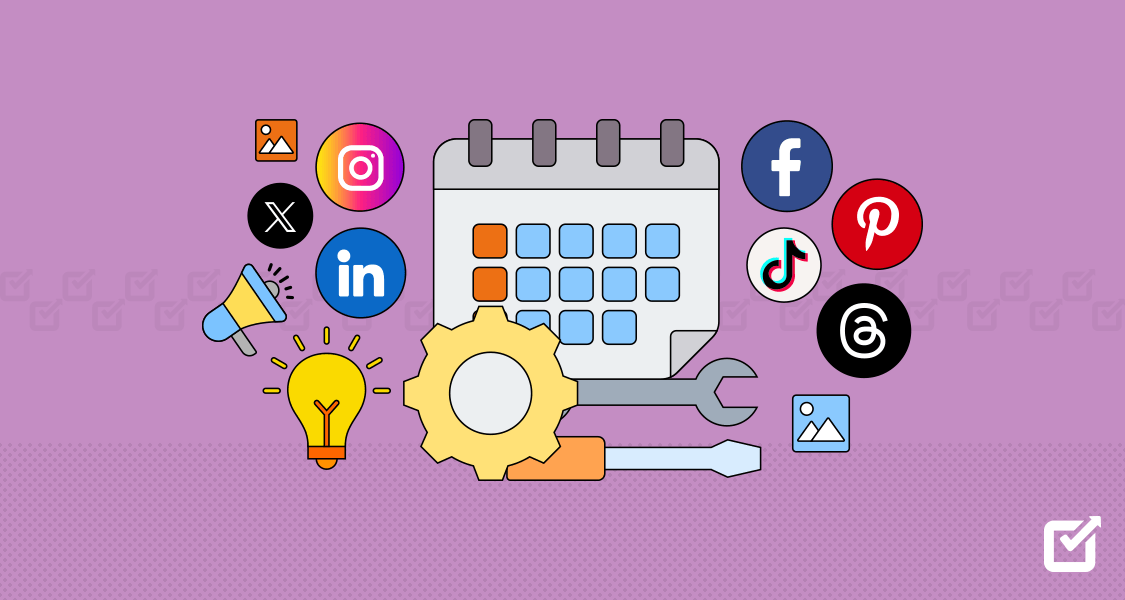


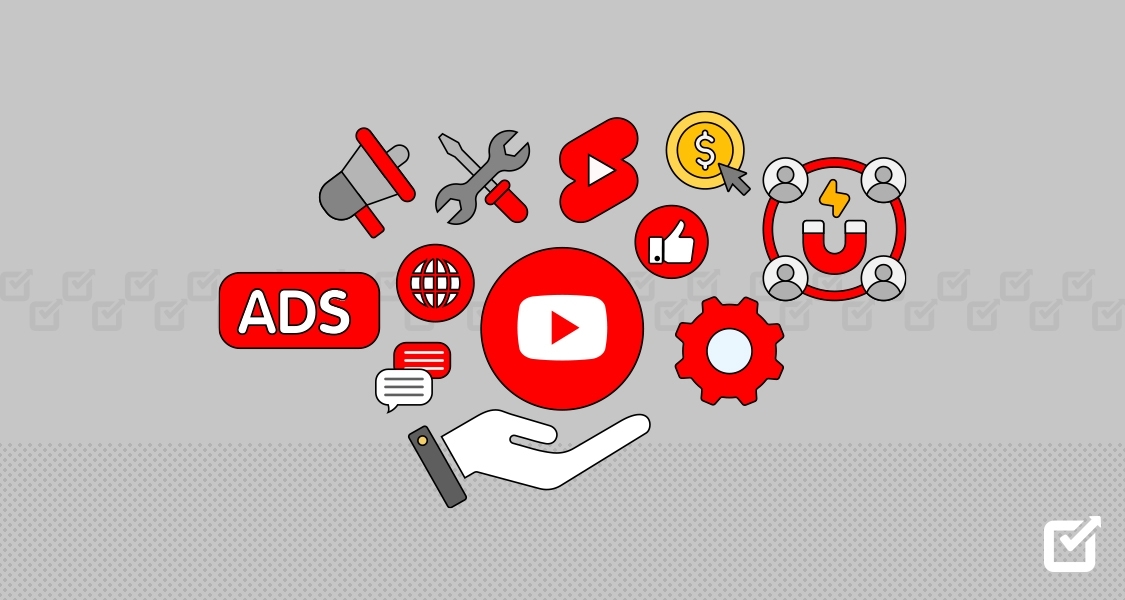
3 comments
Clayton Morgan
I’ve tried a few schedulers in the past, but some of these are new to me. I’ll definitely be giving some of these a go to boost my productivity this year!
John Ray
I just read it, and I already love this article! It’s exactly what I needed. Thank you for listing them. I’m going to try out a few of them.
Helena Mark
Excellent content! I am such a lazy person when it comes to arranging my tasks, and honestly after reading this, you have solved all my problems! I will definitely give Social Champ a try for my productivity. It’s super affordable for me! Thanks for sharing.